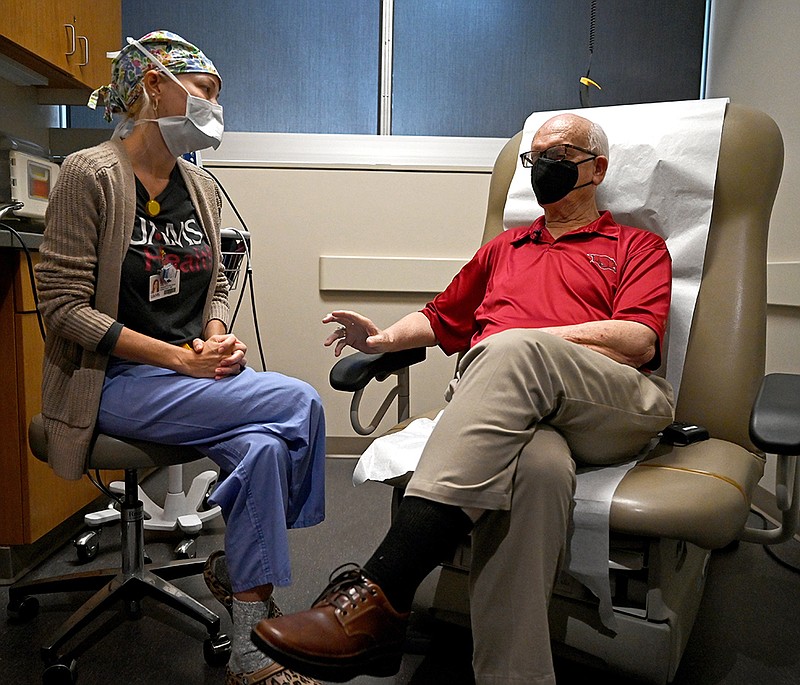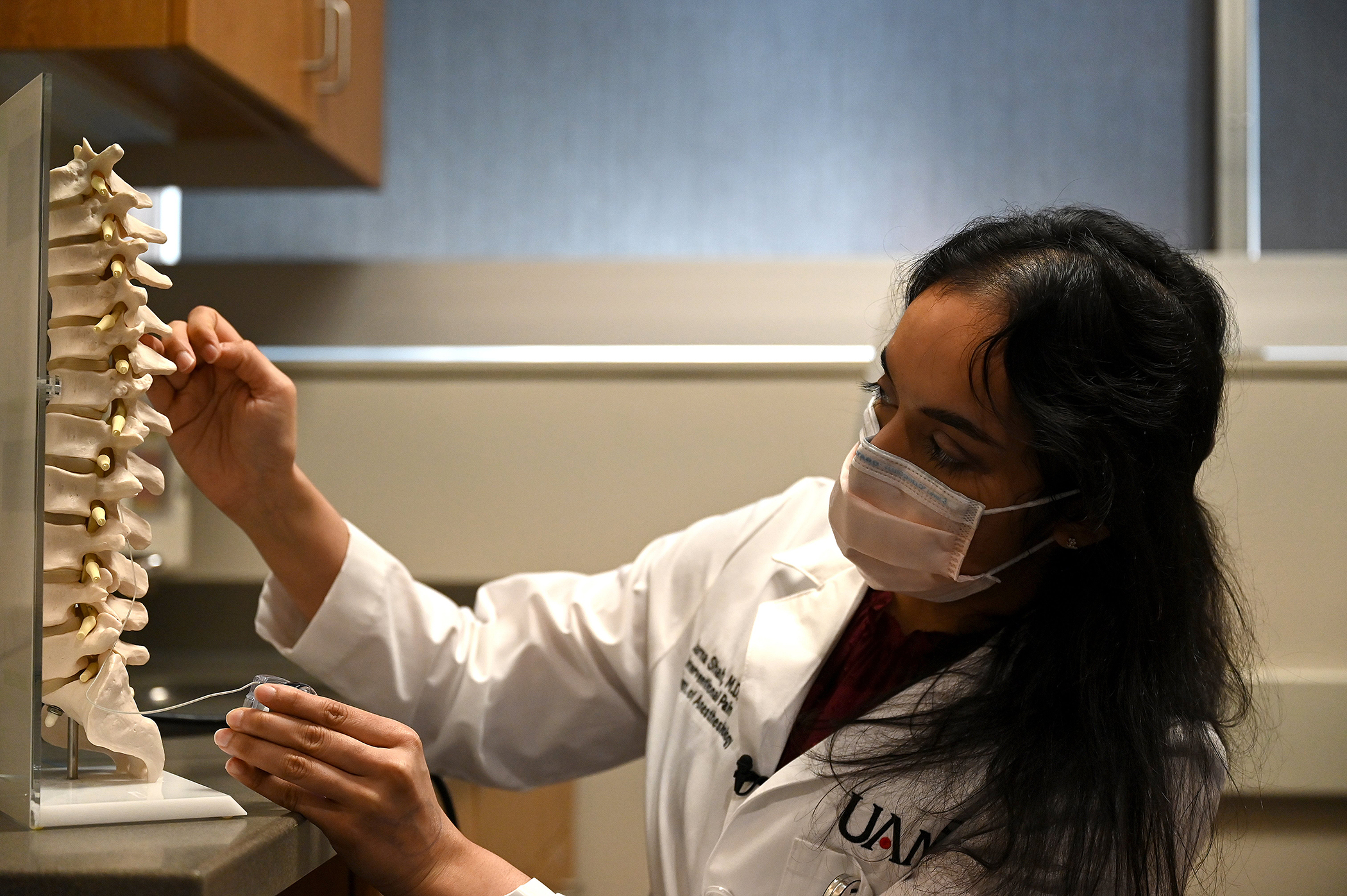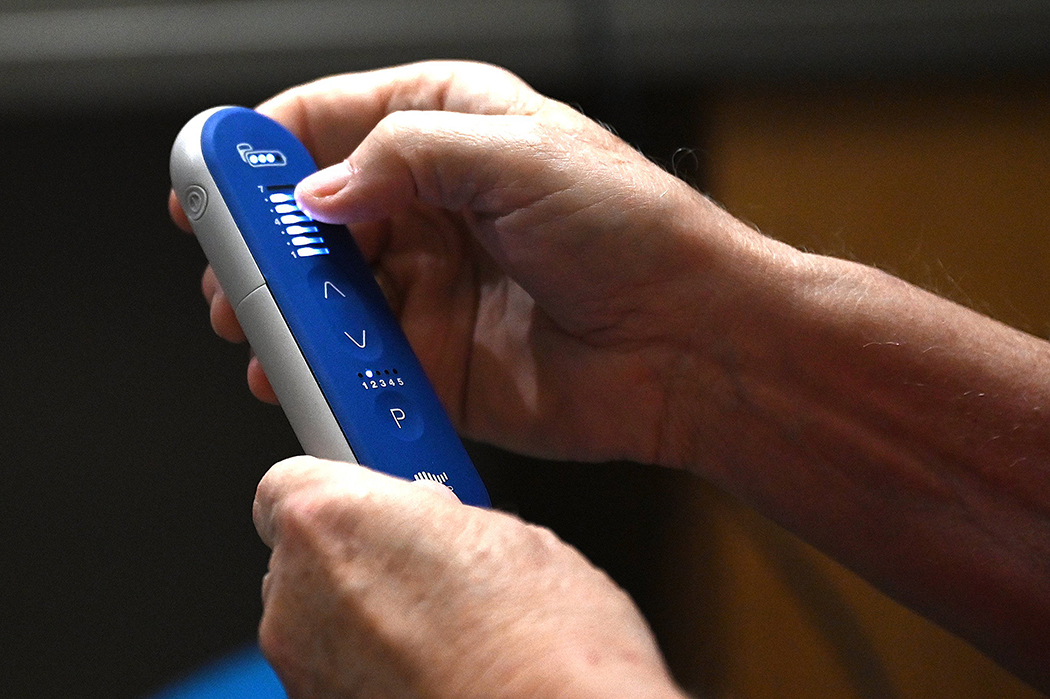Herb Lair couldn't walk five minutes without pain in his lower back before the surgery.
On Friday, six weeks after physicians implanted a device meant to relieve his diabetic neuropathy, Lair, 78, said he was managing 20 minutes on the treadmill without a problem.
"I'm really pleased about that," said Lair, of Harrison, during a follow-up visit with his physician at the University of Arkansas Medical Science Medical Center.
The pain in Lair's lower back and feet began roughly two years ago. He found himself seeking handrails and leaning on shopping carts at the grocery store as he became more infirm. When church let out, he would take the ramp while other congregants filed down the stairs.
Diabetic neuropathy is a type of nerve damage that affects about half of all people with diabetes. Symptoms of the condition range from tingling in the feet to burning pain in the extremities, according to the American Diabetes Association.
Despite attempts to ease the pain and discomfort through traditional forms of treatment -- therapy and major back surgery -- the neuropathy continued to plague Lair, who works as a business consultant.
However, a new treatment option emerged last year when the U.S. Food and Drug Administration approved a medical device designed to relieve back pain by stimulating the spinal cord.
The approval followed a clinical trial led by Dr. Erika Petersen, professor of neurosurgery at UAMS. The study, which involved 216 patients at 18 centers across the United States, found the treatment could provide pain reduction of 50% or more for patients over 12 months. The trial began in 2017 and followed patients for 24 months, according to a news release from UAMS.
After learning about the treatment from his neurologist, Lair, who also has Parkinson's disease, began researching the device manufactured by Nevro Corp., a California-based medical device company.
Neuromodulation, the technology on which the Nevro Corp device relies, has been around for 50 to 60 years, said Dr. Jarna Shah, assistant professor of anesthesiology at UAMS. The device doesn't cure neuropathy but it can mask the pain the condition causes in some people.
"What it involves is simulation at the level of the spinal cord," said Shah. "Basically, if we think about it in the way of traffic on a highway, there is a lot of traffic on the highway and only one signal can come up from the body to the brain. Often that's the pain signal."
A spinal cord stimulator works by replacing the pain signal with an electrical pulse.
The device, which is implanted along with a battery in an outpatient surgical procedure, is about the size of a key fob. Two long thin electrodes wind out of the device and carry current into the spinal cord. Depending on their pain level, patients can adjust the electrical signal using a remote.
Along with relieving pain associated with diabetic neuropathy, the device can help patients dealing with pain after back surgery, said Shah, who is overseeing Lair's treatment.
Depending on usage, the device's battery will last five to seven years before needing to be replaced. Barring malfunction, the device and electrodes don't require replacement.
Spinal cord stimulation may not be a treatment option for all patients.
"If a person needs to have surgery because the changes in their spine are too severe or intense, they may not be a candidate," said Shah.
For patients with active infections or poorly controlled diabetes, getting blood sugar under control is often the first step in treating neuropathy. Shah advised patients to speak with their physicians about their eligibility for the operation.
As in all surgeries, there's a risk of infection and bleeding. Patients taking blood thinners must receive permission from their prescribing physicians because surgeons may need to pause anticoagulant medications during the procedure. The surgery also carries the risk of damaging surrounding nerves and tissues, though physicians use X-ray machines and neuromonitoring to limit this risk, according to Shah.
While UAMS has seen patients come from around the state and beyond to receive the procedure, Shah said other private practice groups are offering the treatment.
After agreeing to the treatment, Lair went through a trial phase at UAMS to determine whether the device would help ease his neuropathy. Shah placed the leads of the electrodes into the epidural space of his spine using needles and taped the device to his back.
"The way I describe it is like taking a Cadillac for a test drive," said Shah. "You have a remote with different channels and you can adjust the setting and see if the stimulation helps with the pain that you're having."
If a patient feels more than 70% relief during the trial phase, which lasts five to seven days, physicians will move to the second step of the procedure and implant the device and battery.
Lair saw a significant improvement in his discomfort during the first phase and opted to have the device implanted in June.
On Friday, Lair said he felt a 70 to 75% improvement in his pain. Simple motions that were once discomforting were becoming routine again, though he would avoid twisting and turning as instructed by his healthcare providers for a couple weeks.
"I always hesitate a little bit until I get twisting and turning, but for the progress I've made and where I am and my expectations, yeah, it's definitely a hole in one," said Lair.
Had it been available when he began considering treatment options, Lair said he would have liked to explore spinal stimulation before turning to major back surgery.
"That's why it's good to get this information out," he said. "There's a lot of things that can be done even at this stage in my life that I think are very productive ... for myself and others."
Gallery: Spinal cord stimulator



